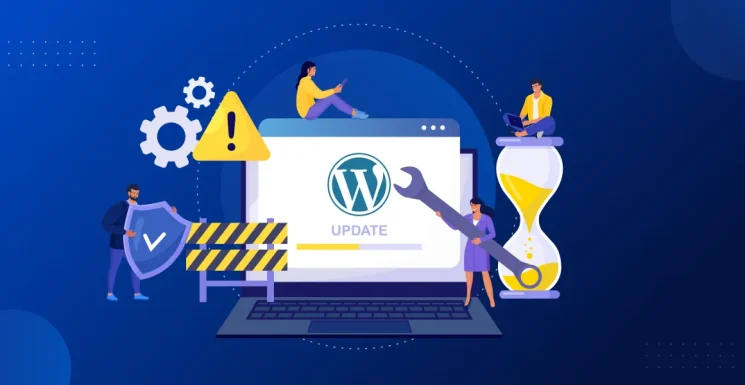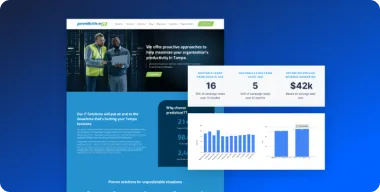If your website is the digital storefront for your business, WordPress maintenance is the janitorial crew, the security guard, the HVAC technician, and the customer‑experience manager rolled into one. It’s the quiet, often invisible work that keeps the doors open, the air fresh, and the merchandise properly arranged.
In 2025—a year of record‑setting cyberthreats, shrinking user attention spans, and Google algorithms that judge a site’s “felt” experience—routine maintenance has graduated from nice‑to‑have to mission critical. Skip it, and you invite hacks, data loss, sluggish performance, lower search rankings, and lost revenue. Embrace it, and your website stays quick, secure, and profitable, projecting the polished image prospects expect from a modern SMB.
Below, we’ll unpack:
- What WordPress maintenance actually involves
- Why the stakes are higher now than ever
- The real‑world risks of neglect
- A practical maintenance checklist
- How upkeep drives SEO rankings and conversions
- Best‑practice tools and workflows
- Choosing between DIY, freelancer, or a professional maintenance service
Let’s dive in.
What is WordPress Maintenance? A Simple Definition
Ask ten site owners what maintenance means and you might hear ten different answers. Some think it’s “clicking the Update button once in a while.” Others assume their web host takes care of everything.
In truth, WordPress maintenance is a disciplined, recurring set of practices that keep three pillars healthy:
- Security – patch vulnerabilities, block intruders, back up data
- Performance – load pages fast, stay online, pass Google’s Core Web Vitals
- Experience – eliminate broken links, ensure forms work, look great on every device
A succinct way to remember it:
Update • Protect • Monitor • Optimize • Back Up.
Miss any one of those verbs and the remaining four start to wobble.
The Core Task Groups
| Maintenance Task | Why It Matters |
|---|---|
| Update WordPress, plugins, & themes | Most exploits target out‑of‑date code. Timely updates close known holes. |
| Automated off‑site backups | If a hack or crash strikes, you can restore quickly instead of rebuilding from scratch. |
| Security hardening & malware scans | Firewalls, brute‑force protection, and daily scans catch threats before customers do. |
| Uptime & error monitoring | Alerts you the moment the site breaks, so you fix it before leads bounce away. |
| Speed & database optimization | Faster load times improve user satisfaction, SEO, and conversion rates. |
| Broken‑link & 404 audits | Dead links hurt credibility and waste Google’s crawl budget. |
| Mobile & browser checks | Guarantees flawless experiences on iOS, Android, Chrome, Safari, Edge, and beyond. |
| Technical‑SEO tune‑ups | Healthy sitemaps, clean redirects, and schema keep search engines happy. |
| Conversion‑path tests | Ensures forms, carts, and CTAs keep working after every change. |
Maintenance is not a plug‑in you install once; it’s a habit—weekly, monthly, and quarterly cycles that preserve a site’s integrity over time.
Why WordPress Maintenance Is Critical in 2025
A Perfect Storm of Threats
- Record vulnerability volume. Security analysts logged nearly 6,000 new WordPress vulnerabilities in 2023, and 95% were in plugins and themes. Automated bots began scanning for unpatched sites within hours of each disclosure.
- Small businesses are prime targets. Forty‑three percent of cyber‑attacks now hit SMBs, yet only 14% feel prepared to defend themselves.
- Zero‑day exploits now hit at headline speed. When a high‑profile e‑commerce plugin disclosed a flaw last year, attackers compromised thousands of stores before breakfast on the U.S. East Coast.
User Patience Has All but Vanished
Research updated for 2025 shows a mere 100‑millisecond slowdown in mobile load times can cut conversions by 8%. An extra full second can wipe out 7% more. Meanwhile, 46% of consumers say they never return to a slow or broken site. Speed and stability have moved from “nice” to “non‑negotiable.”
Google Judges Experience, Not Just Keywords
Since rolling Core Web Vitals into its ranking algorithm, Google treats performance—and, by extension, upkeep—as a first‑class ranking factor. About three‑quarters of the “page‑experience” signals Google evaluates (LCP, INP, CLS, HTTPS, mobile friendliness) map directly to routine maintenance tasks.
Business Dependence on Digital
COVID‑era habits never reversed. Prospects vet vendors online first, even for local B2B services. If your site is down or defaced, there’s no receptionist to apologize. Your reputation tanks in real time.
The Risks of Neglect
Neglecting maintenance is like skipping dentist visits: the decay is invisible until the toothache hits. Common failure modes include:
- Hack & Defacement – Out‑of‑date plugins create an entry point; attackers inject spam or redirect visitors to phishing pages. Google blacklists you; cleaning the mess can cost thousands.
- Data Loss – A hosting hiccup or human error deletes the database, and you discover your “backup plugin” quietly stopped running months ago.
- White Screen of Death – A plugin auto‑update conflicts with your theme, rendering every page blank. Leads, ad clicks, and staff productivity grind to a halt.
- SEO Free‑fall – Broken internal links, slow pages, and malware warnings signal “low‑quality site” to search bots. Rankings slip, organic traffic evaporates.
- Conversion Drain – A form stops submitting or an SSL certificate expires, killing trust. You keep buying Google Ads, but nobody fills the cart.
That spiral can be lethal for an SMB whose margin for error is thin.
A Practical Maintenance Checklist
Below is a cadence many agencies—including Pronto Marketing—follow for high‑stakes business sites:
| Frequency | Task | Typical Tool Set |
|---|---|---|
| Daily | Off‑site backups (files + DB) | UpdraftPlus, Jetpack VaultPress |
| Security scans & firewall rules | Wordfence, Sucuri, Cloudflare | |
| Uptime ping (5‑min) | UptimeRobot, Pingdom | |
| Weekly | Core / plugin / theme updates | WP‑CLI, ManageWP |
| Review update logs; rollback if needed | Staging site, Git, host snapshots | |
| Monthly | Optimize database & media | WP‑Optimize, ShortPixel |
| Broken‑link audit + 301 redirects | Broken Link Checker, Redirection | |
| Check Core Web Vitals & load speed | PageSpeed Insights, WP Rocket | |
| Quarterly | Mobile / browser UX sweeps | BrowserStack, real devices |
| Disaster‑recovery drill (test restoring backup) | Host staging or local dev | |
| Annually | Plugin/theme spring‑cleaning—remove abandonware | Repository checks, Exploit DB |
Pro tip: Pair each maintenance window with a tiny functional test: submit a form, run a test checkout, click your primary CTA on mobile. Catch glitches while you are the visitor.
How WordPress Maintenance Fuels SEO and Conversions
Speed Is the New Currency
Search engines reward speed; humans demand it. Sites that load under 2 seconds on mobile see substantial boosts in dwell time and purchase behaviors. When retailer AutoAnything shaved 1.2s, sales jumped 13%. That gain didn’t come from more marketing—it came from performance tuning, a maintenance discipline.
Security > Trust > Conversions
Browsers now flag mixed‑content or expired SSL sites with stark “Not Secure” labels. Shoppers drop off instantly. Regular certificate renewal, mixed‑content scans, and malware cleanups are maintenance tasks that preserve the little green padlock—and buyer confidence.
Zero Downtime = Zero Lost Ad Spend
Every minute your site is offline during a paid‑traffic campaign is wasted dollars. Continuous uptime monitoring and rapid response protect your ROAS.
Technical SEO Hygiene
Broken links, redirect chains, bloated CSS, unused JavaScript—Google measures them all. Routine link audits and code clean‑ups keep crawl efficiency high and indexation errors low, directly lifting rankings.
The upshot: maintenance amplifies every other marketing dollar. Skip it, and you’re siphoning fuel from your own growth engine.
Best‑Practice Workflows & Tool Stack for WordPress Maintenance
- Stage → Update → Test → Deploy. Never run significant updates on a live site first.
- Automate the boring parts. Let tools handle backups and routine scans, freeing humans for judgment calls.
- Keep PHP current (8.2+). New PHP versions deliver hefty speed & security gains.
- Prune unused plugins. Fewer plugins = fewer attack vectors and easier updates.
- Lean on a CDN & full‑page caching. Many managed hosts provide both, but WP Rocket + Cloudflare is a killer combo.
- Document everything. Changelogs save guesswork when troubleshooting.
- Monitor Core Web Vitals monthly. Treat red metrics as non‑compliant defects, not “nice to address later.”
- Enforce 2‑factor authentication for admins. A must in 2025.
Adopt even half these habits and your maintenance burden drops while your site’s resilience spikes.
DIY, Freelancer, or Professional Service?
| Approach | Pros | Cons | Good Fit |
|---|---|---|---|
| DIY | Lowest cost; full control | Time‑intensive; learning curve; no 24/7 cover | Hobby or micro‑site |
| Freelancer | Affordable expertise; flexible | Single point of failure; variable availability | Simple brochure site |
| Maintenance Service / Agency | Team coverage; 24/7 monitoring; bundled edits | Higher monthly fee | Revenue‑critical SMB / MSP |
Pronto Marketing’s WordPress Maintenance plans start at $99/mo and include core updates, daily backups, security scans, and uptime monitoring, delivered by a 24/7 team . For many SMBs, that fee is cheaper than one emergency clean‑up.
When vetting any provider, ask:
- Do you test updates on staging?
- How fast do you respond to downtime?
- Will you clean malware at no extra charge?
- How often do I receive performance reports?
- Can I cancel any time?
Clear answers signal a mature maintenance operation.
The Economics of WordPress Maintenance: Prevent vs. Repair
| Scenario | Upfront Cost | Failure Cost |
|---|---|---|
| Managed maintenance plan | $99–$299 per month | — |
| DIY + premium plugins | ~$200 per year | — |
| One hack clean‑up | — | $500–$5,000 + SEO recovery |
| Eight‑hour PPC downtime | — | $1,000s in wasted ad spend |
| Data‑loss rebuild | — | Weeks offline + dev fees |
Insurance is cheap until you need it; then it is priceless. Maintenance is the website analogue.
Take Your Next Step
- Audit your site against the checklist above.
- Patch urgent gaps (no backups? legacy PHP? fix those now).
- Choose your maintenance model—DIY, freelancer, or service.
- Set a real calendar (weekly, monthly, quarterly tasks).
- Track results—load time, uptime, lead volume—to tie maintenance directly to revenue.
Want the Hassle Off Your Plate?
Pronto Marketing has spent 15 years keeping thousands of WordPress sites—many for MSPs and other service firms—fast, secure, and conversion ready. Our flat‑fee plan combines proactive maintenance with human support, so you never scramble when WordPress throws a curveball.
Stop worrying about updates at midnight. Hand off maintenance and get back to running your business!






